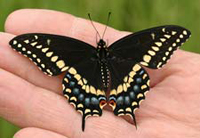
SCIENTIFIC NAME
Papilio polyxenes
DESCRIPTION
The blackness of its body and wings is embellished with two rows of yellow spots. The female’s yellow spots, while not as bold as the male’s, are adorned with a more distinctive blue band between the pale bands of yellow. In contrast, the male is garnished with more yellow tones than blue. Both sexes have two prominent orange eyespots on their hind wings close to their tails.
RANGE
A skilled flier, the Black Swallowtail zips along only feet above the ground. This species can be found in southern Manitoba and northwestern Ontario, in southern Ontario and southern Quebec, and across the Maritimes, with the exception of Newfoundland.
HABITAT
Black Swallowtails can be found in a wide variety of habitats — damp meadows, open fields, roadsides, vacant lots, backyards, and cultivated farmland. This makes the species one of the most popular garden butterflies and one of the easiest to attract. You can invite black swallowtails to your garden by planting thistles, milkweed, red clover, and purple coneflower along with members of the carrot family, such as carrots, dill, fennel, and parsley, for the caterpillars. Select a spot that receives four to six hours of sunlight each day. This will provide an opportunity for the butterflies to bask in the sun while warming their wings for flight. Avoid the use of pesticides, as black swallowtails are very sensitive to these chemicals during all stages of their life cycle.
DIET
Adults feed on a wide array of flowers but their caterpillars need leaves of plants in the parsley family such as the native Golden Alexanders (Zizia aurea and Zizia aptera) as well as non-natives like Queen Anne’s Lace, carrot and dill.
BEHAVIOUR
undefinedPRIMARY ECOSYSTEM ROLES
Pollinator






